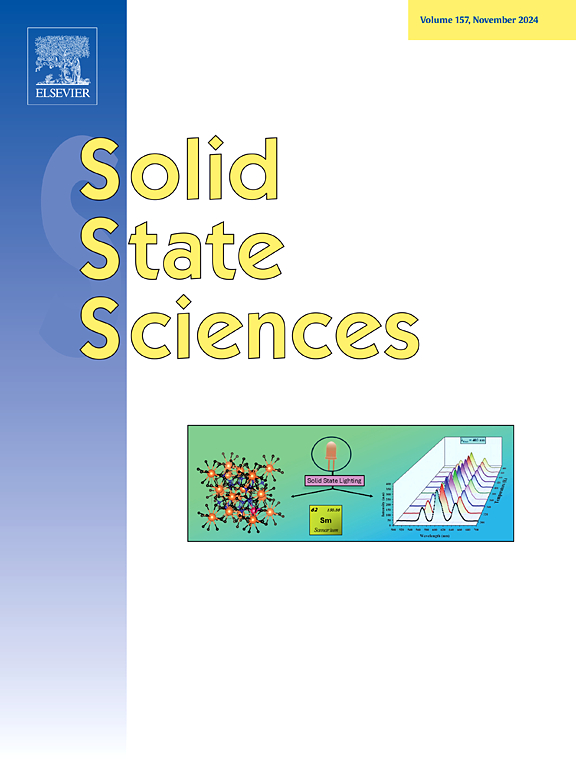Synthesis of manganese oxides with defects for MO degradation
IF 3.4
3区 化学
Q2 CHEMISTRY, INORGANIC & NUCLEAR
引用次数: 0
Abstract
A low-temperature (30 °C) procedure for the synthesis of mixed-valent nanoparticles of manganese oxides is developed through the MnO4− reduction by ascorbic acid (AA) and potassium iodide (KI) with 3 molar ratios (AA: KI = 1:3, 1:1, and 3:1). The samples were dried at 90 °C and calcined at 600 °C. The dried products exhibited low crystallinity with ratios 1:3 and 1:1 and a more developed one with the ratio 3:1. A new tetragonal MnO2-type was formed with AA: KI = 1:1 at 90 °C while the calcined samples showed the formation of crystalline manganese oxides with defects. The application of the calcined products in the oxidation of Methyl orange (MO) showed that Mn0.98O2 formed by the ratio AA: KI = 1:3 at 600 °C was more active, registering 92.4 % of degradation after 1 h at 40 °C. The activities of AK11 and AK31 formed by α-MnO2, α-Mn2O3, and Mn0.965O followed the content of α-MnO2 and registered 89.37 and 85.86 %, respectively, under the same conditions. The synthesized samples exhibited antiferromagnetic behavior with coercivity values ranging from 31 to 48.6 Oe and exchange bias values from 67 to 132 Oe for the dried samples at 90 °C and 9 to 66.5 Oe for the calcined samples at 600 °C. The three products formed by nanoparticles reacted through direct oxidation processes via complex redox mechanisms that depended on the nature of manganese oxide, the presence of metal defects and potassium content.

含缺陷氧化锰的合成及其对MO的降解作用
通过抗坏血酸(AA)和碘化钾(KI)以3摩尔比(AA: KI = 1:3, 1:1和3:1)还原MnO4−,开发了低温(30°C)合成混合价锰氧化物纳米颗粒的工艺。样品在90℃下干燥,在600℃下煅烧。当比例为1:3和1:1时,产品的结晶度较低,当比例为3:1时,产品的结晶度较发达。在AA: KI = 1:1的条件下,在90℃下形成了一种新的四方型二氧化锰,而煅烧后的样品则形成了带有缺陷的结晶型二氧化锰。将焙烧产物应用于甲基橙(MO)的氧化实验表明,在600℃条件下AA: KI = 1:3形成的Mn0.98O2活性更高,在40℃条件下1 h降解率为92.4%。α-MnO2、α-Mn2O3和Mn0.965O形成的AK11和AK31活性紧随α-MnO2含量,在相同条件下分别为89.37%和85.86%。合成的样品具有反铁磁行为,在90℃下干燥样品的矫顽力值为31 ~ 48.6 Oe,交换偏置值为67 ~ 132 Oe,在600℃下煅烧样品的交换偏置值为9 ~ 66.5 Oe。纳米颗粒形成的三种产物通过复杂的氧化还原机制直接氧化反应,这取决于氧化锰的性质、金属缺陷的存在和钾的含量。
本文章由计算机程序翻译,如有差异,请以英文原文为准。
求助全文
约1分钟内获得全文
求助全文
来源期刊

Solid State Sciences
化学-无机化学与核化学
CiteScore
6.60
自引率
2.90%
发文量
214
审稿时长
27 days
期刊介绍:
Solid State Sciences is the journal for researchers from the broad solid state chemistry and physics community. It publishes key articles on all aspects of solid state synthesis, structure-property relationships, theory and functionalities, in relation with experiments.
Key topics for stand-alone papers and special issues:
-Novel ways of synthesis, inorganic functional materials, including porous and glassy materials, hybrid organic-inorganic compounds and nanomaterials
-Physical properties, emphasizing but not limited to the electrical, magnetical and optical features
-Materials related to information technology and energy and environmental sciences.
The journal publishes feature articles from experts in the field upon invitation.
Solid State Sciences - your gateway to energy-related materials.
 求助内容:
求助内容: 应助结果提醒方式:
应助结果提醒方式:


